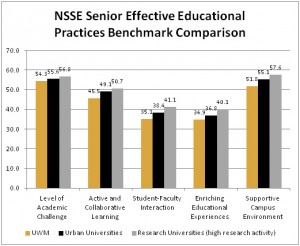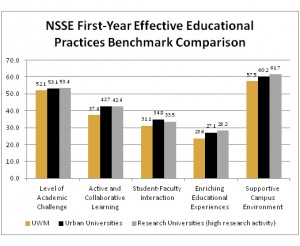Findings from NSSE can be used by participating institutions to compare their performance with other schools. In 2011, 751 institutions participated in the NSSE, with responses from over 537,000 students from across the U.S. and Canada. In 2011, the two peer comparison groups to which UWM finding are compared include the self-selected and identified “Urban Universities” consortium and those institutions considered, like UWM, to be part of the Carnegie Classification of “Research Universities with high research activity”.
The Summary Reports provide an overview of the major findings from the survey. Data is presented for first-year and senior respondents separately and by peer group. The Executive Snapshots are concise overviews that provide selected findings and peer comparisons. The Detailed Data section provides frequency distributions, means, and detailed statistics for each of the questions contained on the NSSE.
NSSE has developed five indicators of effective educational practice which institutions can use to assess their performance and compare themselves with peer institutions. Using groups of similar questions from the survey, NSSE creates benchmark scores for the five indicators: a score off zero would mean that every student chose the lowest response option for every question, and 100 would mean every student chose the highest response to every item. Although benchmarks are reported on a 0-100 scale, they are not percentages. See below for more information regarding the definition and rationale of each indicator.
- Level of Academic Challenge
- Challenging intellectual and creative work is central to student learning and collegiate quality. Colleges and universities promote high levels of student achievement by emphasizing the importance of academic effort and setting high expectations for student performance.
- Active and Collaborative Learning
- Students learn more when they are intensely involved in their education and asked to think about what they are learning in different settings. Collaborating with others in solving problems or mastering difficult material prepares students for the messy, unscripted problems they will encounter daily during and after college.
- Student-Faculty Interaction
- Students learn firsthand how experts think about and solve practical problems by interacting with faculty members inside and outside the classroom. As a result, their teachers become role models, mentors, and guides for continuous, life-long learning.
- Enriching Educational Experiences
- Complementary learning opportunities enhance academic programs. Diversity experiences teach students valuable things about themselves and others. Technology facilitates collaboration between peers and instructors. Internships, community service, and senior capstone courses provide opportunities to integrate and apply knowledge.
- Supportive Campus Environment
- Students perform better and are more satisfied at colleges that are committed to their success and cultivate positive working and social relations among different groups on campus.

